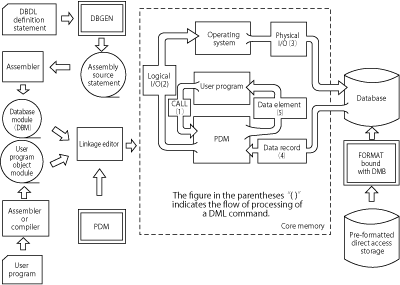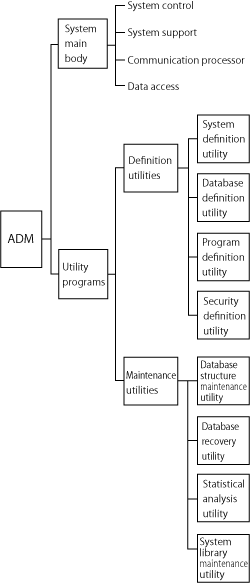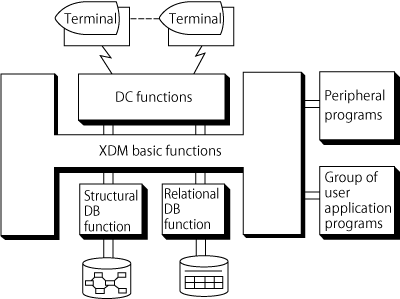From around 1970, when computers began to be used on an expanded scale, database systems that could independently handle user data began attracting public attention. The database system is a total system in which multiple independent business programs (inventory management program, sales management program, etc.) access the common information set (data bank) to increase processing efficiency.
Before the advent of databases, each business program had a unique data file, data were transferred between business programs via files, and operations such as sorting and merging were performed when the data were transferred. As a result, redundant data overlapped, causing problems such as inconsistency in the content due to file updating, wasteful file maintenance costs, etc. These problems were solved with the arrival of database systems.
Meanwhile, the use of computers in online systems also spread rapidly in the 1970s. The DB/DC (database/data communication) system was a database system that had a communication function enabling online use of databases.
(1) PDM
PDM is the acronym for "Practical Data Manager." PDM was a host-language type database management system that was simple and highly practical and used COBOL or an assembly language as the parent language. Being a network structure database for medium scale DB systems shipped in 1974, PDM operated under
NDOS,
EDOS and EDOS-MSO. From 1976,
VOS1,
VOS2 and
VOS3 also supported PDM.
Figure 1 shows a conceptual diagram of the PDM system. To separate the definition of data from a user program and secure independence of the data, PDM supported data definition languages (DBDL) and data manipulation languages (DML). As shown in Figure 1, the DBGEN program converted the DBDL definition statement into an assembly source, and then the assembler created a database module (DBM). The user program issued a database manipulation instruction to PDM in a data manipulation language (DML) via CALL.
 Figure 1 "Conceptual diagram of the PDM system"
Figure 1 "Conceptual diagram of the PDM system"
(2) ADM
ADM was the acronym for “Adaptable Data Manager.” ADM was a DB/DC system for large-scale systems equipped with data communication functions. Hitachi shipped an EDOS-MSO version of ADM in 1974 and the VOS2/VOS3 versions in 1976.
ADM was a hierarchical structure database that provided powerful means of achieving user system integration. It had the following features:
- A powerful file management function, and a simple, highly flexible communication function
ADM has a simple interface with a user program and is equipped with functions such as a multitask function, a message scheduling function and a security function.
- An extension of the OS
The interface between the OS and the user is separated from the user’s program and centrally managed in order to increase processing efficiency and make effective use of the system resources.
- Extensibility of the user system and optimization of the operation environment are taken into account
Figure 2 shows the system configuration for ADM.
- System control
The core element of ADM that controls the starting and stopping of the system or the user program and all processing tasks while the ADM system is running.
- System support
A group of common service modules including memory management and logging.
- Communication processor
Performs processing of the communication circuit including the interface with the OS.
- Data access
Executes access to the database in response to a request from the user program.
- Definition utilities
Utilities for defining the system, database, user program and security
- Maintenance utilities
Utilities for reorganization and recovery of the database, analysis of the system operation status, update of the system library, etc.
 Figure 2 "System configuration for ADM"
Figure 2 "System configuration for ADM"
(3) XDM
In the 1980s, further progress in application of databases required DB/DC systems to become more diversified, more complex and larger, and to have greater capacities. In addition, international standardization of DB interfaces advanced, NDL (Network Database Language) was adopted for structural databases and SQL (Structured Query Language) was adopted for relational databases. Consequently, Hitachi developed the new DB/DC product XDM with the aim of substantially expanding the scale and the applications in order to provide a successor to existing DB/DC products whose systems were approaching their limits.
XDM supported both structural and relational DB. For structural DB, Hitachi in 1986 shipped XDM/SD, which supported a structural database combining a hierarchical DB and a network-type DB based on international standard NDL.
For relational DB, Hitachi developed RDB1 in 1984, prior to XDM, and XDM/RD in 1989. XDM/RD adopted a relational DB model that complied with international standard SQL, and was applicable not only to information-related, non-uniform business operations, but also to key uniform business operations.. Features of the product included a higher DB performance achieved with an integrated database processor (IDP) mechanism, support for wide-area complex systems and support for high-performance DB.
Figure 3 shows the configuration for XDM.
 Figure 3 "Configuration for XDM"
Figure 3 "Configuration for XDM"
XDM was a data management system that combined a database function and a data communication function, and operated under VOS3. XDM had the following features:
(a) A DB/DC basic architecture that supported large scale and high performance
- Overcoming the limitations of system size
Responded to expanded user business operations through drastic increase in system size, including expansion of the database capacity to 6,400 gigabytes, execution of the UAP (user application program) in a 2-GB virtual space with 31-bit addressing, and simultaneous execution of up to 1,500 UAPs.
- Responding to high performance
Increased system use efficiency in a multiprocessor environment with a concurrent access method in which database processing tasks from multiple UAPs were executed concurrently, and raised the transaction throughput. In addition, reduced I/O frequency and achieved high-speed access by making the database on the disk resident on the storage.
(b) Realization of high productivity with a consistent system development/management environment
- Centrally managed DB/DC environment definition information necessary for system operation using a dictionary system. This drastically cut operation/management man-hours.
- Facilitated UAP creation by incorporating the DB/DC manipulation language into COBOL and PL/I host languages.
- Embedded a system development support program EAGLE2 to achieve efficient execution of the total process, from UAP creation to testing.
(c) Realization of a rich array of data services
Provided both a structural database for uniform business operations and a relational database for non-uniform business operations in order to respond to users’ diverse business applications. In addition, these two types of databases could be accessed from the same UAP.




